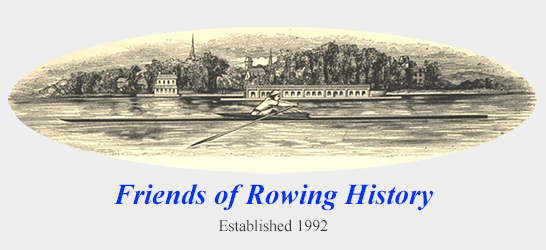A Brief Time Line of Rowing History
Thomas E. Weil
Before 1850
This chronology highlights some of the significant dates in the evolution of rowing as the first modern sport, and has been prepared as part of a larger project for the Friends of Rowing History and the National Rowing Foundation. The number of references to races before 1840, which is by no means comprehensive, is intended to give some indication of the extent to which rowing contests preceded other team sport activities in the United States. Several items were drawn from the “Selected Chronology” in Chris Dodd’s STORY OF WORLD ROWING (1992). I am grateful to Chris for his permission to use those references, which are noted. My thanks also to Bill Miller for his contributions relating to the development of rowing technology, which are also noted. Finally, all history raises questions, and some of the dates and events presented below are subjects of debate among rowing historians – caveat reader! Any mistakes are my responsibility alone. Proposed corrections or suggestions for this timeline may be sent to teweil@mac.com.
B.C. · Oared vessels began to be used for transport, commerce, fishing, life-saving and war, but, while there are occasional references in classical texts to boat racing, rowing primarily for exercise, non-ceremonial recreation or competition was not common before 1800.
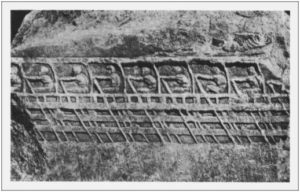
Acropolis Museum, Athens
1274 · The first reference to a “regata” appeared in Venetian documentation; Venice’s dependence on water transport provided a natural venue for the evolution of medieval and Renaissance water festivals. By 1315, the Venetian regata included boat races among other forms of aquatic display and entertainment [Dodd].
1454 · The first Lord Mayor’s water procession was held in London [Dodd], which was to grow to include numerous magnificent guild barges, and to continue for over four centuries, until 1856. The colorful annual event, with its pomp and ceremony and liveried watermen, undoubtedly contributed to initiation at Eton in 1793 of the Procession of the Boats.
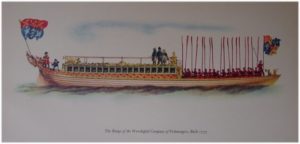
1715 · Thomas Doggett established a prize for watermen in their first year out of apprenticeship, to be raced for on the Tideway in London (August 1), that is now one of the oldest, continually running athletic contests in the world. The Coat and Badge that were awarded brought fame, though little fortune, to the wearers, who were also eligible to man the Royal Barge on state occasions.
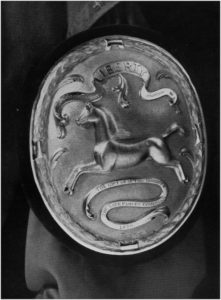
1756 · A race in New York between a Cape Cod whaleboat and a New York pettiauger was won “with the greatest ease” by the former.
1768 · A regatta was held at Walton-on-Thames [Dodd].
1775 · A major water festival and regatta, described in a paper of the day as a “novel amusement recently introduced from Venice,” was held at Ranelagh Gardens at Chelsea on the Thames (June 23). An event like this could now draw royal patronage and commissions, such as the engagement of Handel to compose his “Water Music.”
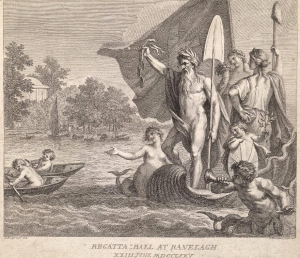
Thomas E. Weil Collection
1790 · The Star Club and the Arrow Club were active on the Thames in London.
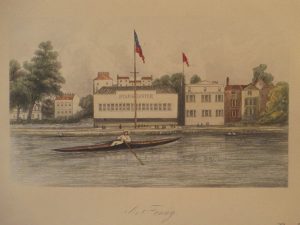
1793 · The first recorded Procession of the Boats was held at Eton College, England’s leading boy’s private school located outside London on the Thames at Windsor where the custom of organizing groups of boys from the same master’s house to obtain a boat for pleasure, exercise or a contest with another house became institutionalized.
1805 · The first boat race was held in Australia [Dodd].
1807 · A boat race took place in New York over a course from the Whitehall Stairs to Blackwell’s Island and return.
1811 · Two New York Whitehall fours, the Knickerbocker and the Invincible, raced from Harsimus, New Jersey to the Battery flagstaff.
The first records are made of boating at Westminster School in London.
1814 · A regatta held in Chester included a race for women for a two guinea prize.
1815 · The first college boat club was organized at Oxford University, and the first recorded contest among the Oxford college boat clubs for Head of the River was won by Brasenose.
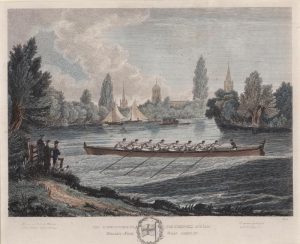
River & Rowing Museum (Thomas E Weil Collection)
1816 · The first Canadian boat race was held in St. John’s Harbor, Newfoundland (August 10), and continues today as the “Quidi Vidi” regatta.
1818 · The Star and Arrow boat clubs joined to form the Leander Club in London.
The four-oared American Star beat the New York in a race from Williamsburg, Long Island to Castle William, Governors Island.
1823 · The Knickerbocker Club became the first boat club to be organized in the United States.
Two four-oars, the Whitehall and the Richmond, raced from Robbins Reef Light to Castle Garden, the Whitehall victorious.
1824 · The Whitehall boat American Star, manned by four New York watermen, defeated the Certain Death from the British warship Hussar, racing four miles from the Battery flagstaff to Hoboken Point and back for a $1,000 prize before 50,000 spectators (December 9); the winning boat was presented as a gift to the Marquis de Lafayette on his farewell visit to New York the following year.
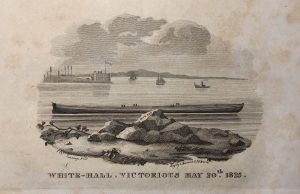
Thomas E Weil Collection

1826 · A regatta was held in Halifax, Nova Scotia (July).
1827 · The first college boat club was organized at Cambridge University, and the first recorded contest among the Cambridge college boat clubs for Head of the River was won by Trinity.
1828 · Anthony Brown of Newcastle-on-Tyne, England, developed a form of outrigger for racing boats [Dodd].
1829 · In their first contest, Oxford defeated Cambridge in eight oared cutters before 20,000 spectators at Henley-on-Thames, England (June 10), where the river offers about a mile and a quarter of straight course. Ultimately known simply as the Boat Race, this fixture of the British sports scene and summer social calendar moved to the Tideway for the second contest, in 1836, where it has been an annual event, with few exceptions, each March or April since 1839.
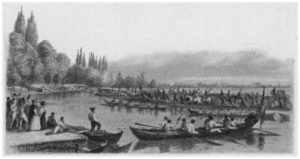
Thomas E Weil Collection
Eton commenced a storied boat race rivalry with Westminster School in London (July 27) that marked the beginning of inter-mural schoolboy rowing.
Regattas in England were held in Portsmouth, Southsea and Gosport [Dodd].
1830 · The Wingfield Sculls were first contested for the amateur sculling championship of the Thames.
1831 · The first English professional sculling championship race was held between two watermen, C. Campbell and J. Williams, in London.
1833 · Seven eights and four sixes raced in a Philadelphia regatta (November).
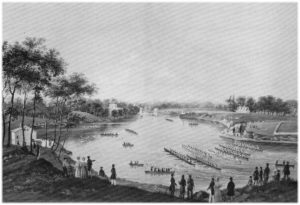
1834 · Durham Regatta in England was founded after almost 20 years of aquatic festivities celebrating the victory at Waterloo.
WALKER’S MANLY EXERCISES, the first book to extol the virtues of rowing for fitness and health, was published first in London, then in Philadelphia (1836).
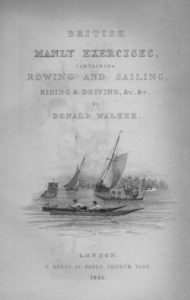
Walker’s Manly Exercises,
Bill Miller Collection
The first rowing association, the New York (or Castle Garden) Amateur Boat Club Association, was organized.
A double-scull defeated a pair-oar in what became known as the “Jersey Blue Race” from Jersey City to Robbin’s reef and return.
Regattas were held among established clubs in Philadelphia.
In a New York Harbor contest of two six-oars manned by Whitehall watermen, the Wave bested the Eagle (July 21). The Wave was again victorious in the first regatta of the New York Amateur Boat Club Association (September 19), held at Castle Garden.
1836 · Lyrics and music titled “Light May The Boat Row” were published in honor of the New York Boat Clubs (the Wave won again, in a nine-boat race on September 19); sheet music with rowing related themes or illustrations appeared for the next century.
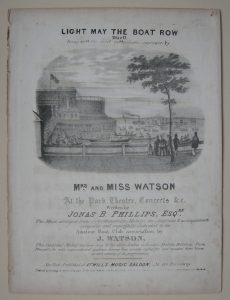
Hamburg RC was organized as the first boat club for Germans [Dodd].
1837 · Two pair-oared match races were held in New York (July 18 and 19), followed by two four-oared races (August 4 and 13). Ten thousand spectators watched the six-oared Wave three-peat in the third New York Amateur Boat Club Association regatta (September 25), while the six-oar Disowned won a match for $2,000 over seven miles against the Geo. Washington (September 26). Newburgh, New York began sponsoring regattas for six-oared boats, and added four-oared events in later years (1839, 1841 and 1842). Poughkeepsie also held a regatta for six-oars on the Hudson River (August 13), followed by an 1839 regatta for six-oars and four-oars.
The Canton Regatta Club was formed in China [Dodd].
1838 · The Societe Havraise de l’Aviron became the first French rowing club [Dodd].
Match races in New York included the victory of the six-oar Wizzard-Skiff over Kosciusko (June 1), the triumph of the four-oared Whitehall over the Passaic (June 11), the defeat by the four-oared Shamburgh of Whitehall of the Independence of Newark in a five mile race from Robbin’s Reef to Castle Garden for $2,000 (September 10), the loss of $1,000 by the Disowned to the Spark in a five mile race, and the victory of the four-oared Fairy over the Brooklyn.
1839 · The first Henley Regatta was held, establishing the “Henley” distance of about a mile and a quarter as the principal alternative to the Tideway four mile “classic” distance. The Regatta received Royal sponsorship in 1851.
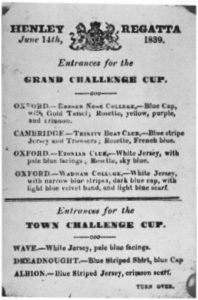
Match races in New York in 1839 included the suspicious victory of the four-oared Shakspeare over the Shamburgh over a course from Robbin’s Reef to Castle Garden for $2,000, perhaps the first fixed race in U.S. rowing (June 2), the victory of the four-oared Duane over the Willis over a two and a half mile course down the Hudson from Washington Market, and return, for $500 a side (August 1), and the victory of the six-oared Ann, of Peekskill, manned by professionals, over the amateurs of the Wave, its first defeat ever (October 1), before a crowd of 15,000. In a same day re-match, the amateurs turned the Wave over to a crew of Whitehallers who bested the Ann in a race from the Battery to Bedloe’s Island and back for $1,000. In Philadelphia, 7,000 viewed a six-oared regatta on the Schuylkill (July 18).
1840’s · Illustrations of boat races first appeared in English newspapers and magazines.
1841 · The Newburgh, NY regatta for eight six-oars featured the first elimination heats in a U.S. regatta (July 14); a race among nine four-oars followed the same day.
1842 · The first publication devoted to rowing as a sport, A TREATISE ON THE ART OF ROWING AS PRACTISED AT CAMBRIDGE, appeared in England.
Four eight-oared boats raced over the Chelsea course in a regatta in East Boston (August 3).
1843 · In one of the legendary contests in the sport, following the illness of one of their crew, seven Oxford oarsmen, stroked by the brother of author Thomas Hughes, defeated a Cambridge eight over the Henley course.
The first U.S. collegiate boat club was organized at Yale (May 24).
The Royal Thames Regatta was organized as the first of several annual contests for professional crews on the Tideway at London.
Stephen Roberts claimed the singles championship of New York after defeating Sydney Dorlon in two of three races (September 29).
1844 · A racing single with outriggers and an inboard keel made its appearance on the Thames [Dodd].
The first boat club was organized at Harvard.
1845 · Out-rigged racing boats, most effectively modified by Harry Clasper, professional waterman from Newcastle-on-Tyne, appeared on the Tideway.
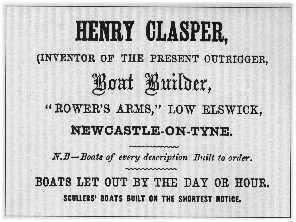
The first modern sport and the eventual US “national sport” shared common ground as a four-oared regatta was held (September 22) at Elysian Fields, Hoboken; that same year, the Knickerbocker Base Ball Club was formed, and their playing grounds at the Elysian Fields became the birthplace of baseball.
1846 · The Ghent club was organized in Belgium [Dodd].
The Arrow Club was formed in St. Petersburg, Russia [Dodd].
1849 · Henry David Thoreau published A WEEK ON THE CONCORD AND MERRIMACK RIVERS, the chronicle of a trip with his brother in an oared boat in 1839; numerous journals of oared travels appeared over the next four decades, culminating in the classic THREE MEN IN A BOAT, published by Jerome K. Jerome in 1889.
